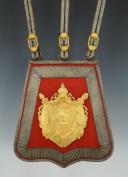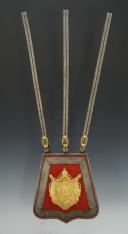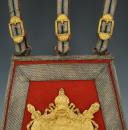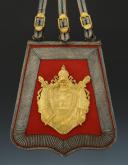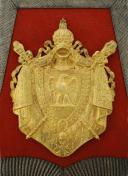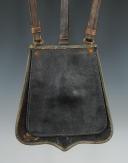
SABRETACHE BY MUSIC CONDUCTOR PIERRE MAROTEL OF THE REGIMENT OF CHASSEUR À CHEVAL OF THE IMPERIAL GUARD, Second Empire (1852-1865). 14621
SABRETACHE BY MUSIC CONDUCTOR PIERRE MAROTEL OF THE REGIMENT OF CHASSEUR À CHEVAL OF THE IMPERIAL GUARD, Second Empire (1852-1865). 14621
In leather covered with black patent morocco and black velvet. Pattelette (H 29 cm; L in the upper part 18.2 cm; L in the lower part 26.8 cm) covered with scarlet cloth and framed with gold braid (width 2.9 cm), the center decorated with large Imperial weapons in stamped and gilded brass (H 17.2 cm; L 12.6 cm). The three suspension straps (L 2 cm) are in leather covered in dark green morocco covered with green piped silver braid with gilded brass buckles.
Very good state.
France.
Second Empire (1852-1865).
NOTE: This sabretache is the only example of its type that I am aware of.
BIOGRAPHY: Pierre Marotel born in Pont à Mousson on September 2, 1813, named knight of the Legion of Honor on May 23, 1857, he received the military medal on August 9, 1854 when he was trumpet-major in the 8th hussars, died February 14, 1885.
HISTORY:
The regiment of hunters on horseback of the Imperial Guard is a French cavalry unit of the Second Empire, part of the Imperial Guard. Established in 1855 in Compiègne by mixed elements of light cavalry and African hunters, its last squadrons were transferred in February 1871 to the cavalry of the line.
He distinguished himself for the first time in Italy during the Battle of Magenta, then shortly after that of Solferino. These first promising engagements would also be the last, since the Guard horse hunters took no part in the Franco-Prussian War of 1870. In February 1871, the regiment was merged with the 13th horse hunter regiment. The predominantly green uniform – the traditional color of mounted hunters – includes a black skin headdress, a coat and madder pants with false boots.
In 1854, two years after the advent of the Second Empire, Napoleon III reestablished the Imperial Guard, an elite military corps attached to his person. The latter thus takes up the traditions of the first Imperial Guard, formed in 1804 by Napoleon I and dissolved in 1815. The cavalry of the Guard, originally strong with two regiments — cuirassiers and guides — gradually expanded. new units. On December 20, 1855, an imperial decree established the creation of four additional cavalry regiments: among them, that of the horse hunters of the Imperial Guard.
In April 1856, the project came to fruition. For the mounted hunters of the Guard, the organization is carried out in a scattered manner. The new corps must in fact be formed mainly from elements of the recently dissolved 4th African Hunter Regiment. At the time of its disappearance, this regiment was in Crimea and it was there that the first four squadrons were set up. At the same time, the two other squadrons were organized in Algeria, the 5th in Mostaganem and Constantine and the 6th in Algiers. Detachments provided by the three other African hunter regiments as well as the 1st and 4th hussar regiments completed the numbers. Towards the middle of 1856, the squadrons from Crimea and Algeria met at the Compiègne depot, where Napoleon III reviewed them on November 7. The regiment has six squadrons for a total of 1,393 officers, non-commissioned officers and soldiers.
Now complete, the mounted hunters of the Guard were placed under the orders of Colonel Adolphe Charles de Cauvigny, who ceded his post in 1863 to Aristide de Gondrecourt. The latter led the regiment for four years. His successor, Alexandre Ernest Michel, was promoted to brigadier general in 1870 and led the charge of French cuirassiers at the Battle of Reichshoffen. Colonel de Montarby replaced Michel at the head of the corps in 1868, making him the last commander of the Imperial Guard horse hunters.
Under the Second Empire, the life of the regiment was marked by the frequent change of garrisons: Saint-Germain-en-Laye, Paris, Melun, Fontainebleau, Compiègne... During the war against Prussia in 1870, the depot squadron of hunters on horseback of the Guard reinforces the 1st mixed cavalry marching regiment; another squadron contributed to the formation of the 1st mixed marching regiment under the orders of Lieutenant-Colonel Leroy de Lanauze. The corps of hunters was officially dissolved on October 25, 1870 and then took the name of the Ex-Garde Hunter Regiment. It was under this name that it survived until February 4, 1871, when its elements were transferred to the 13th regiment of horse hunters.
Campaigns and battles:
In April 1859, France and the Kingdom of Piedmont-Sardinia declared war on Austria: it was the start of the Italian campaign. On May 4, the cavalry of the Guard was transported by train to Marseille where it met under the orders of Division General Louis-Michel Morris. With the guides, the horse hunters form the 3rd brigade under the orders of General Cassaignoles. On the 8th, the order was given to the Guard cavalry division to move towards Italy. Placed at the head of the column, the hunters arrived in Genoa on May 24 then in Alexandria on the 28th, while the 1st squadron of the regiment was placed at the disposal of the main headquarters.
In leather covered with black patent morocco and black velvet. Pattelette (H 29 cm; L in the upper part 18.2 cm; L in the lower part 26.8 cm) covered with scarlet cloth and framed with gold braid (width 2.9 cm), the center decorated with large Imperial weapons in stamped and gilded brass (H 17.2 cm; L 12.6 cm). The three suspension straps (L 2 cm) are in leather covered in dark green morocco covered with green piped silver braid with gilded brass buckles.
Very good state.
France.
Second Empire (1852-1865).
NOTE: This sabretache is the only example of its type that I am aware of.
BIOGRAPHY: Pierre Marotel born in Pont à Mousson on September 2, 1813, named knight of the Legion of Honor on May 23, 1857, he received the military medal on August 9, 1854 when he was trumpet-major in the 8th hussars, died February 14, 1885.
HISTORY:
The regiment of hunters on horseback of the Imperial Guard is a French cavalry unit of the Second Empire, part of the Imperial Guard. Established in 1855 in Compiègne by mixed elements of light cavalry and African hunters, its last squadrons were transferred in February 1871 to the cavalry of the line.
He distinguished himself for the first time in Italy during the Battle of Magenta, then shortly after that of Solferino. These first promising engagements would also be the last, since the Guard horse hunters took no part in the Franco-Prussian War of 1870. In February 1871, the regiment was merged with the 13th horse hunter regiment. The predominantly green uniform – the traditional color of mounted hunters – includes a black skin headdress, a coat and madder pants with false boots.
In 1854, two years after the advent of the Second Empire, Napoleon III reestablished the Imperial Guard, an elite military corps attached to his person. The latter thus takes up the traditions of the first Imperial Guard, formed in 1804 by Napoleon I and dissolved in 1815. The cavalry of the Guard, originally strong with two regiments — cuirassiers and guides — gradually expanded. new units. On December 20, 1855, an imperial decree established the creation of four additional cavalry regiments: among them, that of the horse hunters of the Imperial Guard.
In April 1856, the project came to fruition. For the mounted hunters of the Guard, the organization is carried out in a scattered manner. The new corps must in fact be formed mainly from elements of the recently dissolved 4th African Hunter Regiment. At the time of its disappearance, this regiment was in Crimea and it was there that the first four squadrons were set up. At the same time, the two other squadrons were organized in Algeria, the 5th in Mostaganem and Constantine and the 6th in Algiers. Detachments provided by the three other African hunter regiments as well as the 1st and 4th hussar regiments completed the numbers. Towards the middle of 1856, the squadrons from Crimea and Algeria met at the Compiègne depot, where Napoleon III reviewed them on November 7. The regiment has six squadrons for a total of 1,393 officers, non-commissioned officers and soldiers.
Now complete, the mounted hunters of the Guard were placed under the orders of Colonel Adolphe Charles de Cauvigny, who ceded his post in 1863 to Aristide de Gondrecourt. The latter led the regiment for four years. His successor, Alexandre Ernest Michel, was promoted to brigadier general in 1870 and led the charge of French cuirassiers at the Battle of Reichshoffen. Colonel de Montarby replaced Michel at the head of the corps in 1868, making him the last commander of the Imperial Guard horse hunters.
Under the Second Empire, the life of the regiment was marked by the frequent change of garrisons: Saint-Germain-en-Laye, Paris, Melun, Fontainebleau, Compiègne... During the war against Prussia in 1870, the depot squadron of hunters on horseback of the Guard reinforces the 1st mixed cavalry marching regiment; another squadron contributed to the formation of the 1st mixed marching regiment under the orders of Lieutenant-Colonel Leroy de Lanauze. The corps of hunters was officially dissolved on October 25, 1870 and then took the name of the Ex-Garde Hunter Regiment. It was under this name that it survived until February 4, 1871, when its elements were transferred to the 13th regiment of horse hunters.
Campaigns and battles:
In April 1859, France and the Kingdom of Piedmont-Sardinia declared war on Austria: it was the start of the Italian campaign. On May 4, the cavalry of the Guard was transported by train to Marseille where it met under the orders of Division General Louis-Michel Morris. With the guides, the horse hunters form the 3rd brigade under the orders of General Cassaignoles. On the 8th, the order was given to the Guard cavalry division to move towards Italy. Placed at the head of the column, the hunters arrived in Genoa on May 24 then in Alexandria on the 28th, while the 1st squadron of the regiment was placed at the disposal of the main headquarters.
Price :
6 500,00 €
| Destination | Envoi recommandé | Envoi Recommandé + Express |
|---|---|---|
| Shipping France | 14,00 € | 50,00 € |
| Shipping Europe | 20,00 € | 60,00 € |
| Shipping world | 44,00 € | 100,00 € |
Insurance (1%) :
65,00 €
Reference :
14621
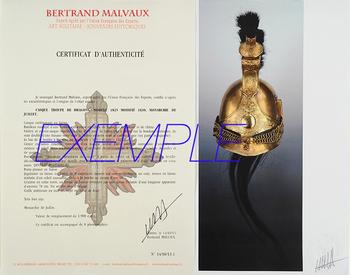
Next update Friday, december 26 at 13:30 PM
FOR ALL PURCHASES, PAYMENT IN MULTIPLE CHECKS POSSIBLE
bertrand.malvaux@wanadoo.fr 06 07 75 74 63
SHIPPING COSTS
Shipping costs are calculated only once per order for one or more items, all shipments are sent via registered mail, as this is the only way to have proof of dispatch and receipt.
For parcels whose value cannot be insured by the Post, shipments are entrusted to DHL or Fedex with real value insured, the service is of high quality but the cost is higher.
RETURN POLICY
Items can be returned within 8 days of receipt. They must be returned by registered mail at the sender's expense, in their original packaging, and in their original condition.
AUTHENTICITY
The selection of items offered on this site allows me to guarantee the authenticity of each piece described here, all items offered are guaranteed to be period and authentic, unless otherwise noted or restricted in the description.
An authenticity certificate of the item including the description published on the site, the period, the sale price, accompanied by one or more color photographs is automatically provided for any item priced over 130 euros. Below this price, each certificate is charged 5 euros.
Only items sold by me are subject to an authenticity certificate, I do not provide any expert reports for items sold by third parties (colleagues or collectors).
FOR ALL PURCHASES, PAYMENT IN MULTIPLE CHECKS POSSIBLE
bertrand.malvaux@wanadoo.fr 06 07 75 74 63
An authenticity certificate of the item including the description published on the site, the period, the sale price, accompanied by one or more color photographs is automatically provided for any item priced over 130 euros. Below this price, each certificate is charged 5 euros.
Only items sold by me are subject to an authenticity certificate, I do not provide any expert reports for items sold by third parties (colleagues or collectors).
